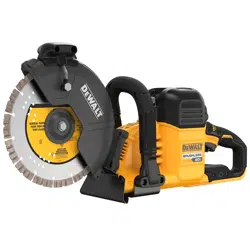Loading ...
Loading ...
Loading ...

ENGLISH
14
3. Line up wheel with cutting line. Be sure nothing is near
or in line with thewheel.
4. To turn the tool on, push the lock‑off lever
18
toward
the back of the tool, then depress the trigger switch
1
.
Wait for the blade to reach full speed, then slowly feed
wheel into work with firm pressure, working along the
cutting line. Do not force the tool. Cut only as deep as
needed to reduce the amount of dust produced. For
maximum efficiency and wheel life, keep the wheel
speedhigh. To maintain control of the cut‑off machine,
release pressure as you near the end of yourcut.
5. To stop tool, release trigger switch
2
.
6. Set the lock‑off button
3
to the locked postion and
make sure the cutting wheel has come to a complete
stop before setting the cut‑off machinedown.
NOTE: Denser and thicker material should be cut in several
passes. The maximum depth of cut of each pass should not
exceed 1.0" (25.4mm).
Cutting Slabs (Fig.L, M)
WARNING: Before making any cuts, make sure the slab
is properly secured on a non‑slipsurface.
1. Cut a guiding groove along a marked cuttingline.
2. Cut deeper into the slab, never exceeding the maximum
depth of cut of 3.25" (83mm), and leaving a ridge of
uncut material
26
as shown on Fig.L.
3. Cut through the slab at each end to ensure the slab does
notchip.
4. Break theslab.
NOTE: Curves must be made into the slab using several
straight cuts as shown in Fig. M, always making sure that the
cutting wheel does not becomewedged.
Cutting Pipe (Fig.N, O)
WARNING: Before making any cuts, make sure the
pipe is properly secured on a non‑slipsurface.
WARNING: Pipe may break at any time during the cut.
Take precautions to maintain control of the tool and
avoid fallingdebris.
If the outer diameter of the pipe is smaller than the
maximum cutting depth
• Make one cut straight down, starting at the top of the
pipe through to the bottom of thepipe.
If the outer diameter of the pipe is larger than the
maximum cutting depth
Several cuts are needed on larger pipes and it is important to
make the cuts in the propersequence.
If the pipe is in-ground and can not be rolled, make
the following sequence of cuts
1. Cut a guiding groove along a marked cutting line making
sure to avoid any metal reinforcements ifpossible.
2. Start at the bottom of the pipe and use only the front
and upper part of the cutting wheel. This will reduce the
risk of kickback orpinching.
3. Using only the front and upper part of the cutting wheel,
make a cut on the oppsite lower side of thepipe.
4. Make a lateral cut on the top half of thepipe.
CAUTION: Never use the saw over head. When using
water, limit cutting to the horizontal position to reduce
the risk of water entering thetool.
WARNING: Wet cut method is to be used only with a
diamondblade.
WARNING: The recommended flow rate should be at
least 20fl. oz. (0.6 liters) per minute. Cutting at a flow
rate less than recommended or cutting for more than
two consecutive hours requires use of NIOSH/OSHA
approved respiratory protection for the operator and
anybystanders.
WARNING: Maximum supplied water pressure not to
exceed 60PSI (4.1bar).
WARNING: Makes sure that water does not flow onto
the abrasive wheel while the cut‑off machine is not
in use. The cutting wheel will absorb water which will
affect thebalance.
NOTICE: Before using the wet cut method, make
sure water will not damage the material being cut or
surroundingproperty.
Attaching the Water Supply
1. Attach the water supply to the quick water
connector
24
.
2. Attach the quick water connector to the water inlet
17
.
3. To regulate the water flow, slowly rotate the water
valve
16
towards to open position until desired flow is
reached as shown in Figure K. To stop the flow of water,
rotate the water valve to the closedpostion.
4. Proceed to cut as described in Making a Cutbelow.
5. After finishing your cuts, run the machine for
3–5seconds with the water valve closed to remove any
residual water from the cuttingwheel.
Removing the Water Supply
1. Turn off and depressurize watersystem.
2. Make sure the trigger switch
2
is in the OFF position and
lock‑off button
3
isengaged.
3. Close the water valve
16
.
4. Disconnect the quick water connector
24
from the
water inlet
17
.
Making a Cut
WARNING: Always make sure the guard is in place and
set for the type of cut you are making.
WARNING: Always use your cut‑off machine so that
the operator and bystanders are not endangered by
potential airborne particles of material being cut,
sparks, or pieces of damaged cuttingwheels.
DANGER: To reduce the risk of serious or fatal injury,
DO NOT change direction during the cut. A change
in direction may produce a high torsional load on the
cutting wheel and cause it to bind or break.
CAUTION: Wear gloves when cuttingmetal.
1. Mark a cutting line on the material to becut.
2. Grasp rear handle
1
and front handle
8
firmly.
Loading ...
Loading ...
Loading ...
